More About Editing Graphic Properties | ||
| ||
Color
The way colors are applied to sub-elements depends on the main object type.
Color on Mechanical Modeler Objects
It is not possible to apply a color to the representation itself but only to the part body and its sub-elements.
If you access the representation properties, the Graphic tab is grayed out. For more information, see Part Design User's Guide: Displaying and Editing Properties: Displaying and Editing Bodies Properties.
Color on Assembly Objects
When applying a color onto an Assembly object, any other element located at a lower level in the specification tree inherits this color and the list displays the color of the Assembly object.
However, the color modification impacts only the display at rendering level and not the graphic properties. This can be useful, for instance, to highlight an object among others without altering its graphic properties. If you want to deactivate the inheritance mechanism, click the Color list: all the elements located at a lower level have their own color back and No Color is displayed in the list.
When working with Edges and points and Shading selected, the color applied to the product is also applied to the mesh but not to lineic elements (edges, sketches, etc.) which turn black. In this case, it is not possible to modify the color of these lineic elements. However, when working with the Edges and points check box selected, the color applied to the product is also applied to lineic elements.
Tip:
No Color lets you deactivate the color inheritance for
Assembly objects. You can then apply a color onto a face without
having to modify the product color. To do so:
|
Color on Surfaces
You can apply a color on sub-elements of a surface.
Let's suppose the
following model:
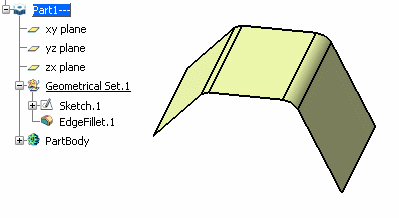
When accessing the graphic properties of the sub-element
"EdgeFillet.1", the fill Color list is available:
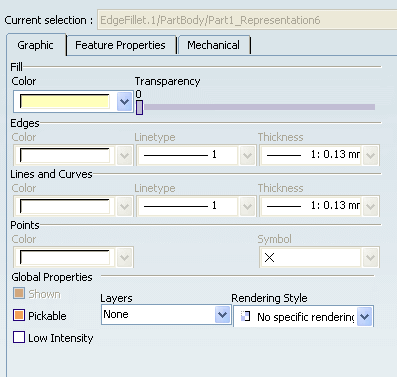
You can then select the desired color from the combo box and click Apply or OK to confirm.
The color is applied to the selected face only:
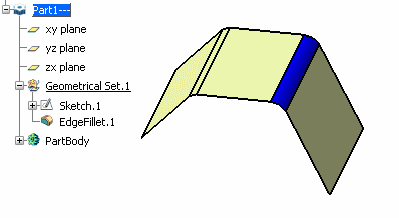
Important:
|
![]()
Low Intensity
The Low Intensity property enables you to filter the visualization of any geometry by applying a specific color.
Elements can be put in low-intensity state by:
- Selecting the Low Intensity check box in the Graphic tab of the Properties dialog box.
- Right-clicking any view from the geometry area or the specification tree then selecting when working with the 2D Layout for 3D Design product. See the documentation of interest for more information.
- Clicking Low intensity background
 in the 2D Visualization toolbar of the Sketcher product or in the
Tools toolbar of the
Generative Shape Design product, for instance. See the documentation
of interest for more information.
in the 2D Visualization toolbar of the Sketcher product or in the
Tools toolbar of the
Generative Shape Design product, for instance. See the documentation
of interest for more information.However, note that representations on a green background (such as measures) are not clearly displayed when set to Low intensity background
 or Unpickable low intensity background
or Unpickable low intensity background because of the superimposition of the low intensity mode's dark
green color:
because of the superimposition of the low intensity mode's dark
green color:
Low intensity background or Unpickable low intensity background is deactivated: 
Low intensity background or Unpickable low intensity background is activated: 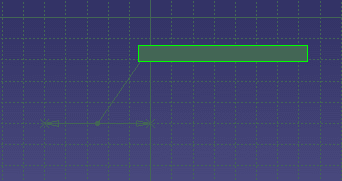
If needed, you can keep the low-intensity state for 2D or 3D objects displayed in Shading with Material rendering style. This means that when you apply the low-intensity state to objects onto which materials have been applied, the low-intensity state is kept even though elements are visualized in Shading with Material.
This is illustrated by the pictures below showing two parts onto which materials have been applied:
Example 1 - Low Intensity is cleared and the
materials applied on the two parts are displayed: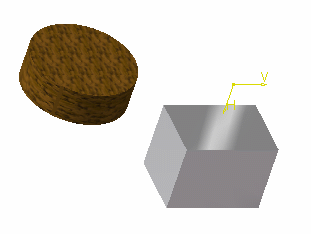
Example 2 - Low Intensity is selected and the materials are not
displayed anymore ; they are overriden by the low-intensity color:
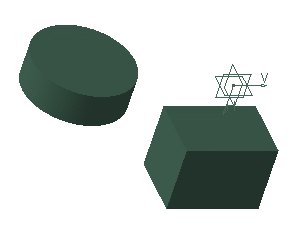
As soon as you clear the Low Intensity option, the materials are displayed.
![]()
Rendering Styles
Rendering styles can be applied only to CATParts or to CATParts embedded in CATProducts. :
- Part body: you can apply a rendering style to each body composing the part body and this, even if a body is embedded into another one. All the elements gathered in the part body or in the body inherit the rendering style of their parent. As a consequence, you cannot apply a rendering style to the child solid features (such as a pad or a fillet).
- Geometrical set: you can apply a rendering style to the geometrical set as a whole and to each child feature in the graph ; each feature may be applied a different rendering style. If no rendering style has been applied to a feature, this feature will be displayed with the rendering style applied to the father element or, if no father exists, with the rendering style of the viewer used to display the feature.
- Shape body: the behavior is identical to the one of the geometrical set except that different child features may share the same visual representation and therefore, the same rendering style.
The following rendering styles are available:
- No Specific Rendering: this is the default mode. You can use it to remove a rendering style that has been previously applied.
- Transparent:
displays the selected object in transparency mode:

- Wireframe:
displays only the selected objects' edges:
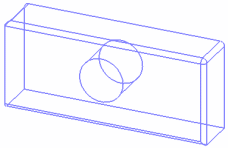
- Shading:
displays the selected object in shading mode:
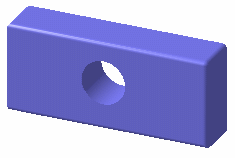
- Shading with Edges:
displays the selected object in shading mode with all edges:
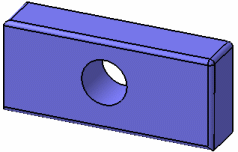
![]()
Inheritance
The inheritance mechanism for the graphic properties varies according to the object type.
Assembly Objects
The following properties can be inherited: color, transparency, line type and line weight.
This inheritance can be deactivated by
doing one of the actions below depending on the property you want to inherit:
- Select No Color in the Color list
- Select No Linetype in the Linetype list
- Select No Width in the Thickness list
- Clear the option next to the Transparency slider.
For more information on graphic properties applied to products, see VPM Editor User's Guide: Managing Graphic Properties in Products.
Mechanical Modeler Objects
There is a specific inheritance mechanism for Mechanical Modeler objects.
- When a mechanical object (a pad, for instance) has been assigned a color, this color is used to display the object. Otherwise, the object is displayed using the color of its father element (i.e. the part body). To reset the inheritance from the father to the children, select Reset properties from the Edit menu or from the pad's contextual menu. Bear in mind that this command cancels any local modification applied to the graphic properties of the pad (including color and transparency) .
- The following properties are set at the part body level and cannot be inherited: point symbol, line thickness and linetype.
For more information on graphic properties applied to bodies, see Part Design User's Guide: Displaying and Editing Properties: Displaying and Editing Bodies Properties.
![]()
Materials
The transparency of a part onto which a material is applied cannot be modified through the part's graphic properties.
When a material has been applied onto a part with
Material selected in View > Render Style >
Customize View (or with Shading with Material![]() selected in the View
toolbar), the graphic properties defined in the
Properties dialog box have no impact on the part display
anymore.
As a consequence, if you need to modify the transparency, for
instance, this must be done in the material properties. For more
information on modifying material properties and on materials in
general, see Real Time Rendering User's Guide.
selected in the View
toolbar), the graphic properties defined in the
Properties dialog box have no impact on the part display
anymore.
As a consequence, if you need to modify the transparency, for
instance, this must be done in the material properties. For more
information on modifying material properties and on materials in
general, see Real Time Rendering User's Guide.